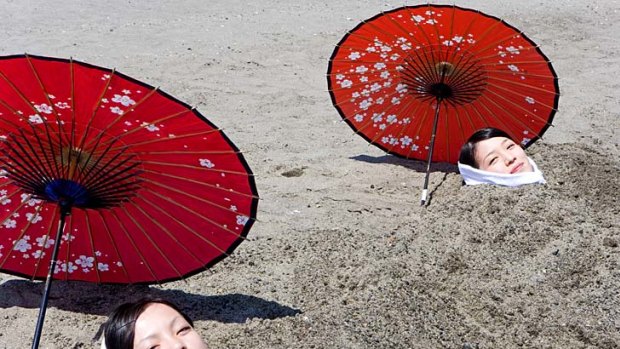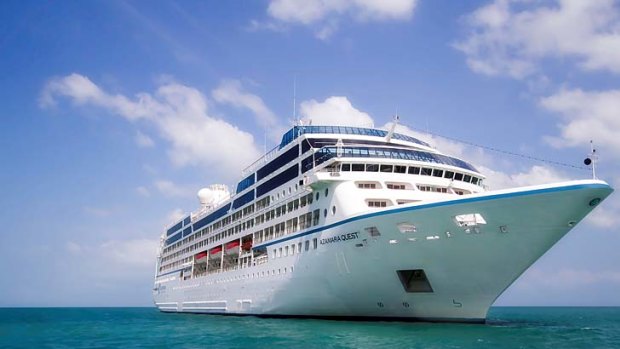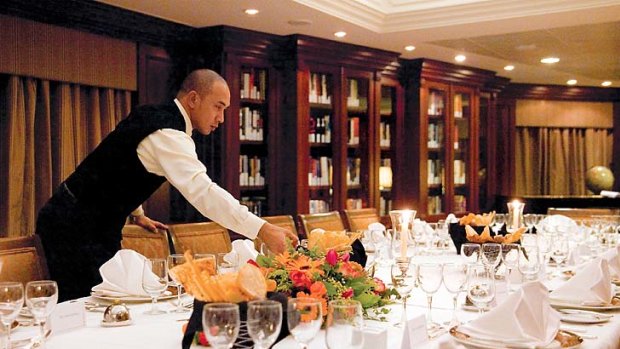
Immersion therapy... hot-sand baths in Ibusuki are fed by underground springs.Credit: Getty Images
Lynne Whiley mixes temple-hopping, sand-bath remedies and fine dining on a boutique Azamara Club cruise in Asia.
The sand is dark, coarse, warm and tended by men who work their shovels with finesse. The pair has scooped a series of steaming pits, each shaped to the outline of an adult body, and by way of a nod invite people to step forward and occupy one. The sand's sheer weight is an immediate, pleasant shock that forces my body to relax, muscles unflexing. Beyond a low wall in front of me is a vast bay, to my right a stand of pine, and around me the quiet, contented sighs of people disappear on the breeze. I slow my breathing - and I'm off.
When I look up at a nearby clock, about 20 minutes have passed and I'm feeling the deep contentment a meditation brings. At Ibusuki, a celebrated hot-sand bath spot on the tip of Kagoshima Bay in southern Japan, that's the point. The ritual is thought to stimulate blood circulation; the salt in the sand to stimulate metabolism. Fed by a volcanic spring far underground, the Japanese have been harnessing the sand's uses for eons, paying to be buried.

Azamara Quest cruise ship.
Those around me include passengers from the boutique cruise vessel the Azamara Quest. Our 700-passenger vessel is docked at Kagoshima as part of a 12-night north Asia exploration from Shanghai, China, to Hong Kong by way of South Korea, Japan and Taiwan. The itinerary mixes sea days with overnight stays in key cities. The Quest and its sister ship, the Azamara Journey, combine big-ship amenities (top-line restaurants, a theatre, big balcony suites, spa and library) with smaller ship attractions (informal ambience, no crowding, no queues). The Azamara line uses ship size to advantage and we sail right into a city's maritime doorstop, as close to street life and markets, taxis, bars and shops as a sea wall allows.
A week after I disembark in Hong Kong, the Quest is crippled by an engine-room fire, injuring several crew members, and the ship limps into Sandakan, Borneo. Not a top-of-mind port to visit, to be sure, but, then, the Azamara line specialises in taking travellers to lesser-known, fascinating places. Which is how I come to disembark at Kagoshima, board a bus and head up narrow mountain passes lined with white magnolia and pines to explore 18th-century-built and still-occupied samurai homes and gardens at Chiran, before taking to those hot sands at the shore of the Ibusuki Iwasaki Hotel. Chiran's domestic artistry seems at odds with Japan's samurai legends until my guide, with a wise smile, says her country's World War II kamikaze pilot training school, now museum, is about a 30-minute drive away.
I could have hired a car in Kagoshima city and driven to Chiran and Ibusuki, but the Azamara line knows a good portion of its guests are seasoned passengers who want immersive onshore experiences, so the company undertakes the logistics while passengers sit back and enjoy.

The Azamara Quest's Prime C restaurant.
A similar degree of effortlessness on my part means I'm delivered by fast bus and ferry from Hiroshima dock to Miyajima island, home of Japan's famously photogenic, vermilion-coloured Itsukushima shrine. The torii gate - appearing to float at high tide - is considered the boundary between sacred island and mundane world, an island thought to have had shrines built on it by fishermen and other mariners since about the 7th century.
A flexible attitude on the part of the Japanese to the spiritual realm means visitors can be equally at ease among Shinto priests as they move from prayer hall to stalls selling temple blessings (ready-made key rings "blessed" to help keep a driver safe on the roads are quick sellers) as they are walking among Buddhist monks and staff who occupy the island's higher ground.
Daisho-in, nestled in the mountain well above the torii gate, is thought to be the oldest Buddhist temple on the island, built after Shingon Buddhism was established here in about the 9th century. Steep sets of stairs take visitors higher into temple grounds where the Daisho temple is surrounded by others, some hosting giant drums and the sound of measured chanting; some dwarfed by nearby golden prayer wheels. Built between Buddhist high ground and the Shinto-occupied shoreline are narrow streets of well-kept homes.
Later, relaxing on my suite's verandah, legs tired from traversing Miyajima's ancient walkways, the Azamara butler service kicks in. Eyup, a middle-aged Turkish man who can sum up a passenger's needs in a glance, lifts my feet, stuffs plump cabin cushions under my knees and ankles, pours me a glass of wine and disappears for 10 minutes, returning with tasting plates from one of the ship's restaurants. This gentle care allows guests to re-energise before dinner and the evening ahead.
I dine one night at the ship's Prime C restaurant with a trio of American women who regularly eat at top restaurants in the US and Europe, listening as they praise the rib-eye and milk-fed veal Prime C serves. The trio is drinking the house wine and I politely ask if that's their concession to economising, given the US economic downturn. Hell no, says one woman; it's because the house wines are so good. Another evening I dine at Aqualina, its seafood menu a magnet for Australian passengers, including a widely travelled, adorable father and daughter from Queensland spoilt for choice on the fresh seafood front at home but delighted with Aqualina's inventive international menu.
Azamara's passenger mix seems primarily English-speaking: Brits, Canadians, Americans and Australians, with a smattering of Asian, European and Middle Eastern guests. The Germans are hard-partying, rarely spotted on deck before midday and seen wearing their sunglasses at night. My usual shipboard haunts include the pool deck, library, coffee bar, spa and the stairs between decks, where Azamara ships, owned by the Royal Caribbean line, excel at exhibiting modern art.
The bridge doesn't intrude on passenger leisure by making frequent announcements on the ship's public broadcasting system; one midday report by captain Leif Karlsson about the ship's position, weather conditions and onboard lectures undertaken by Asian experts suffices. Each cabin has interactive TV, through which customs and immigration procedures, onboard events, port history and culture (and room service) can be accessed.
The ship's nice in the sea, too, Karlsson says. This cruise has experienced sunny days and light sea conditions, but "even on five-metre waves and wind at 40 knots it's not uncomfortable", he says.
"She's 182 metres long and we ride the waves, where bigger ships bang into the waves. We find the speed so she can ride nicely and she's perfect, even in bad weather."
Karlsson says his favourite port is Hong Kong; mine, on this itinerary, is Japan's Kobe. From Kobe, the Shinkansen bullet train whisks me to Kyoto with a handful of US and British passengers for a day of temple-gazing and exploration of Gion's old alleys, where girls and women dressed in geisha costume fleetingly appear between their tea-house engagements.
Later, back in Kobe, a city damaged by earthquake in 1995 and rebuilt at epic speed, a pair of British passengers and I find a tiny old bar-cafe tucked in an alley between modern buildings. The bar's thick wooden roof beams and rough-planed walls are a testament to the built-to-last skills of this port city's former shipwrights and carpenters. We drink our fill of sake before rolling down to the dock, like thousands of mariners have done through the ages, to board a vessel bound for fresh ports.
Lynne Whiley travelled courtesy of Azamara Club Cruises and Cathay Pacific.
FAST FACTS
Getting there
Cathay Pacific has a fare to Hong Kong from Melbourne and Sydney for about $1260 economy class, $7806 business class, including tax. Connect to Dragonair for short flights to Shanghai and other Asian cities.
Cruising there
The Azamara Journey begins its Asian season in November. Itineraries include cruises from Hong Kong to Singapore; Hong Kong to Vietnam and Thailand; Singapore to Burma; and Singapore to Sri Lanka and Mumbai. Prices for a 17-night cruise from Hong Kong are from $US4599 ($4624) a person, twin share. Azamara Quest's 2012-13 itineraries include boutique cruises in Europe, South America and the West Indies.
More information
Sign up for the Traveller Deals newsletter
Get exclusive travel deals delivered straight to your inbox. Sign up now.